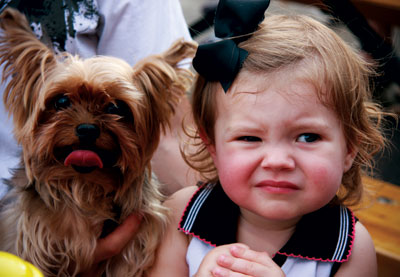All Nonfiction
- Bullying
- Books
- Academic
- Author Interviews
- Celebrity interviews
- College Articles
- College Essays
- Educator of the Year
- Heroes
- Interviews
- Memoir
- Personal Experience
- Sports
- Travel & Culture
All Opinions
- Bullying
- Current Events / Politics
- Discrimination
- Drugs / Alcohol / Smoking
- Entertainment / Celebrities
- Environment
- Love / Relationships
- Movies / Music / TV
- Pop Culture / Trends
- School / College
- Social Issues / Civics
- Spirituality / Religion
- Sports / Hobbies
All Hot Topics
- Bullying
- Community Service
- Environment
- Health
- Letters to the Editor
- Pride & Prejudice
- What Matters
- Back
Summer Guide
- Program Links
- Program Reviews
- Back
College Guide
- College Links
- College Reviews
- College Essays
- College Articles
- Back
Top 10 Kid and Family Friendly Dogs
Dogs are the best family companion. But there are so many different breeds of dogs that you don’t know which one is the best for your family. You could have a family that loves hunting, or a family that likes to stay inside and cuddle up with your kids and dog. This list of top 10 family friendly dogs will be very helpful. Any dog on this list will be exactly what you want it just takes time to find the perfect dog.
10. Bull Dog.
Description: The Bull Dog has a sturdy build that is perfect for kids that like to play rough. It likes living in large houses and apartments. It is not the most energetic dog, but very friendly, loyal, and gets along with other pets.
History of the breed: They were originally bred to help butchers control livestock. By the 15th century they were used in a “sport” called bull-baiting. The dogs were trained to latch onto a lathered bull’s nose and not let go until the dog had pulled the bull to the ground or the bull killed the dog. Bull-baiting was banned in 1835. So they were bred for aggression.
9. Beagle.
Description: They are good for active kids and never too tired to play a game. Beagles are friendly, clever, cheerful, and get along with other pets. But they shed and require brushing and bathing.
History of the breed: Small hound dogs that stood at 8 to 9 inches tall. They were called “Pocket Beagles.” In the 1840's was the development of the Standard beagle. The 20th century was a time when beagles were used for hunting companions.
8. Bull Terrier.
Description: The Bull Terrier is a rambunctious breed that requires a lot of playtime. They’re good for large families and also protective of children. They have a good tolerance of pain.
History of the breed: When dog-fighting became popular a smaller breed was needed that could be easily hidden from the police. That’s when the Bull Terrier was introduced by James Hink from Brimingham, England in the early 1850.
7. Collie.
Description: A gentle dog that doesn't bite and is easily trainable also good for families. Collie’s long hair requires regular grooming. They get along with children and are very protective dogs.
History of the breed: it is believed that the Collie was originated in the hilly border countries of Scotland and Ireland. Farmers and shepherds needed a reliable and intelligent dog to guard the flock and be a great family dog.
6. Newfoundland.
Description: Nicknamed “Natures Babysitter,” they love children and are very protective of them. There gentle, kind, and patient. This dog best suits for a family with open spaces since they are big dog and they’re good swimmers. But they drool and shed a lot. Not considered a proper dog for the yard, instead they like to be inside with its family. Require bathing and a lot of grooming.
History of the breed: They were originated from dogs brought form the island of Newfoundland to England in the early 1800's. “Ship Dogs” used for taking ropes ashore in the North Atlantic seas and retrieved lost fishing gear and rescued humans. There thick double layered coat makes them suited for the work the dog does.
5. Vizsla.
Description: One of the best dog breeds for kids. They have a gentle disposition loyal, affectionate, quiet, and perfect for little kids, obedient, confident, and smart. Form close bonds and learn tricks easily.
History of the breed: Created in Hungary between 900-1300's. They were fast hunting dogs, came to North America in the 1950's.
4. Irish Setter.
Description: Known for red coat, playful, energetic, likes being around people, and play well with children. They need a lot of exercise, good for energetic kids. Smart trainable, good with people in a lot of space.
History of the breed: Created in Ireland during the 1800's. They located birds and have a very good sense of small, also a hunting and gun dog.
3. Poodle.
Description: A smart and gentle dog that is great for kids with allergies because they shed very little, but requires scheduled grooming. Proud and elegant dog that is caring and loyal. Its good nature and patience make it excellent playing partner for any child.
History of the breed: There native to Germany. They worked in swamps as water dogs that were trained to get fallen birds for hunters. The breed’s origin is a mystery.
2. Labrador Retriever.
Description: One of the most popular breeds of dog. The reason for that is because it is protective, loyal, playful, loving, patient, reliable, sweet personality, and intelligent.
History of the breed: Originated during the 1700's. They were originally called Lesser Newfoundland or St. John’s dog. Helped fisherman by going in icy water and bring back fishes that fell off from their hooks, also hauled fishing nets in the water.
1.Golden Retriever.
Description: Kind, smart, confident, and loyal. Neither aggressive nor timid, very patient, this is good for kids, and need a lot of energy.
History of the breed: developed in the 1800's in Britain. Bred as a hunting dog, their grace,
agility, and sweet nature contribute to the dogs popularity as a show dog and a house pet.
There are many options if you are looking for the right dog for your family. I hope this top 10 list will make you decision easier. The Newfoundland or Golden Retriever are both great dogs who can bring lots of love and fun inside of your home.

Similar Articles
JOIN THE DISCUSSION
This article has 0 comments.
